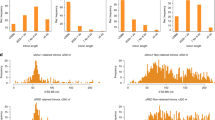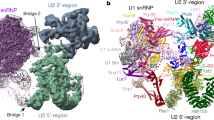Abstract
The polypyrimidine tract binding protein (PTB) binds pre-mRNAs to alter splice-site choice. We characterized a series of spliceosomal complexes that assemble on a pre-mRNA under conditions of either PTB-mediated splicing repression or its absence. In the absence of repression, exon definition complexes that were assembled downstream of the regulated exon could progress to pre-spliceosomal A complexes and functional spliceosomes. Under PTB-mediated repression, assembly was arrested at an A-like complex that was unable to transition to spliceosomal complexes. Trans-splicing experiments indicated that, even when the U1 and U2 small nuclear ribonucleoprotein particles (snRNPs) are properly bound to the upstream and downstream exons, the presence of PTB prevents the interaction of the two exon complexes. Proteomic analyses of these complexes provide a new description of exon definition complexes, and indicate that splicing regulators can act on the transition between the exon definition complex and an intron-defined spliceosome.
This is a preview of subscription content, access via your institution
Access options
Subscribe to this journal
Receive 12 print issues and online access
$189.00 per year
only $15.75 per issue
Buy this article
- Purchase on Springer Link
- Instant access to full article PDF
Prices may be subject to local taxes which are calculated during checkout








Similar content being viewed by others
References
Smith, C.W. & Valcarcel, J. Alternative pre-mRNA splicing: the logic of combinatorial control. Trends Biochem. Sci. 25, 381–388 (2000).
Li, Q., Lee, J.A. & Black, D.L. Neuronal regulation of alternative pre-mRNA splicing. Nat. Rev. Neurosci. 8, 819–831 (2007).
Shin, C. & Manley, J.L. Cell signalling and the control of pre-mRNA splicing. Nat. Rev. Mol. Cell Biol. 5, 727–738 (2004).
Matlin, A.J., Clark, F. & Smith, C.W. Understanding alternative splicing: towards a cellular code. Nat. Rev. Mol. Cell Biol. 6, 386–398 (2005).
Black, D.L. Mechanisms of alternative pre-messenger RNA splicing. Annu. Rev. Biochem. 72, 291–336 (2003).
House, A.E. & Lynch, K.W. Regulation of alternative splicing: more than just the ABCs. J. Biol. Chem. 16 November 2007 (epub ahead of print) (2007).
Nilsen, T.W. The spliceosome: the most complex macromolecular machine in the cell? Bioessays 25, 1147–1149 (2003).
Jurica, M.S. & Moore, M.J. Pre-mRNA splicing: awash in a sea of proteins. Mol. Cell 12, 5–14 (2003).
Will, C.L. & Luhrmann, R. in RNA World (eds. Gesteland, R.F., Cech, T.R. & Atkin, J.F.) 525–560 (Cold Spring Harbor Laboratory Press, Cold Spring Harbor, New York, USA, 2006).
Sharma, S., Falick, A.M. & Black, D.L. Polypyrimidine tract binding protein blocks the 5′ splice site-dependent assembly of U2AF and the prespliceosomal E complex. Mol. Cell 19, 485–496 (2005).
Gozani, O., Potashkin, J. & Reed, R. A potential role for U2AF–SAP 155 interactions in recruiting U2 snRNP to the branch site. Mol. Cell. Biol. 18, 4752–4760 (1998).
Donmez, G., Hartmuth, K., Kastner, B., Will, C.L. & Luhrmann, R. The 5′ end of U2 snRNA is in close proximity to U1 and functional sites of the pre-mRNA in early spliceosomal complexes. Mol. Cell 25, 399–411 (2007).
Kent, O.A. & MacMillan, A.M. Early organization of pre-mRNA during spliceosome assembly. Nat. Struct. Biol. 9, 576–581 (2002).
Kent, O.A., Ritchie, D.B. & Macmillan, A.M. Characterization of a U2AF-independent commitment complex (E′) in the mammalian spliceosome assembly pathway. Mol. Cell. Biol. 25, 233–240 (2005).
Brow, D.A. Allosteric cascade of spliceosome activation. Annu. Rev. Genet. 36, 333–360 (2002).
Staley, J.P. & Guthrie, C. Mechanical devices of the spliceosome: motors, clocks, springs, and things. Cell 92, 315–326 (1998).
Berget, S.M. Exon recognition in vertebrate splicing. J. Biol. Chem. 270, 2411–2414 (1995).
Black, D.L. Finding splice sites within a wilderness of RNA. RNA 1, 763–771 (1995).
Fox-Walsh, K.L. et al. The architecture of pre-mRNAs affects mechanisms of splice-site pairing. Proc. Natl. Acad. Sci. USA 102, 16176–16181 (2005).
Sterner, D.A., Carlo, T. & Berget, S.M. Architectural limits on split genes. Proc. Natl. Acad. Sci. USA 93, 15081–15085 (1996).
Wagner, E.J. & Garcia-Blanco, M.A. Polypyrimidine tract binding protein antagonizes exon definition. Mol. Cell. Biol. 21, 3281–3288 (2001).
Spellman, R. & Smith, C.W. Novel modes of splicing repression by PTB. Trends Biochem. Sci. 31, 73–76 (2006).
Oberstrass, F.C. et al. Structure of PTB bound to RNA: specific binding and implications for splicing regulation. Science 309, 2054–2057 (2005).
Lin, C.H. & Patton, J.G. Regulation of alternative 3′ splice site selection by constitutive splicing factors. RNA 1, 234–245 (1995).
Singh, R., Valcarcel, J. & Green, M.R. Distinct binding specificities and functions of higher eukaryotic polypyrimidine tract-binding proteins. Science 268, 1173–1176 (1995).
Sauliere, J., Sureau, A., Expert-Bezancon, A. & Marie, J. The polypyrimidine tract binding protein (PTB) represses splicing of exon 6B from the â-tropomyosin pre-mRNA by directly interfering with the binding of the U2AF65 subunit. Mol. Cell. Biol. 26, 8755–8769 (2006).
Charlet-B., N., Logan, P., Singh, G. & Cooper, T.A. Dynamic antagonism between ETR-3 and PTB regulates cell type-specific alternative splicing. Mol. Cell 9, 649–658 (2002).
Chan, R.C. & Black, D.L. The polypyrimidine tract binding protein binds upstream of neural cell-specific c-src exon N1 to repress the splicing of the intron downstream. Mol. Cell. Biol. 17, 4667–4676 (1997).
Southby, J., Gooding, C. & Smith, C.W. Polypyrimidine tract binding protein functions as a repressor to regulate alternative splicing of á-actinin mutally exclusive exons. Mol. Cell. Biol. 19, 2699–2711 (1999).
Amir-Ahmady, B., Boutz, P.L., Markovtsov, V., Phillips, M.L. & Black, D.L. Exon repression by polypyrimidine tract binding protein. RNA 11, 699–716 (2005).
Chou, M.Y., Underwood, J.G., Nikolic, J., Luu, M.H. & Black, D.L. Multisite RNA binding and release of polypyrimidine tract binding protein during the regulation of c-src neural-specific splicing. Mol. Cell 5, 949–957 (2000).
Markovtsov, V. et al. Cooperative assembly of an hnRNP complex induced by a tissue-specific homolog of polypyrimidine tract binding protein. Mol. Cell. Biol. 20, 7463–7479 (2000).
Black, D.L. Activation of c-src neuron-specific splicing by an unusual RNA element in vivo and in vitro. Cell 69, 795–807 (1992).
Das, R. & Reed, R. Resolution of the mammalian E complex and the ATP-dependent spliceosomal complexes on native agarose mini-gels. RNA 5, 1504–1508 (1999).
MacCoss, M.J. et al. Shotgun identification of protein modifications from protein complexes and lens tissue. Proc. Natl. Acad. Sci. USA 99, 7900–7905 (2002).
Rideau, A.P. et al. A peptide motif in Raver1 mediates splicing repression by interaction with the PTB RRM2 domain. Nat. Struct. Mol. Biol. 13, 839–848 (2006).
Behzadnia, N. et al. Composition and three-dimensional EM structure of double affinity-purified, human prespliceosomal A complexes. EMBO J. 26, 1737–1748 (2007).
Chiara, M.D. & Reed, R. A two-step mechanism for 5′ and 3′ splice-site pairing. Nature 375, 510–513 (1995).
Bruzik, J.P. & Maniatis, T. Enhancer-dependent interaction between 5′ and 3′ splice sites in trans. Proc. Natl. Acad. Sci. USA 92, 7056–7059 (1995).
Konforti, B.B. & Konarska, M.M. A short 5′ splice site RNA oligo can participate in both steps of splicing in mammalian extracts. RNA 1, 815–827 (1995).
Makarova, O.V. et al. A subset of human 35S U5 proteins, including Prp19, function prior to catalytic step 1 of splicing. EMBO J. 23, 2381–2391 (2004).
Blencowe, B.J. et al. The SRm160/300 splicing coactivator subunits. RNA 6, 111–120 (2000).
Eldridge, A.G., Li, Y., Sharp, P.A. & Blencowe, B.J. The SRm160/300 splicing coactivator is required for exon-enhancer function. Proc. Natl. Acad. Sci. USA 96, 6125–6130 (1999).
Soares, L.M., Zanier, K., Mackereth, C., Sattler, M. & Valcarcel, J. Intron removal requires proofreading of U2AF/3′ splice site recognition by DEK. Science 312, 1961–1965 (2006).
Will, C.L. et al. Characterization of novel SF3b and 17S U2 snRNP proteins, including a human Prp5p homologue and an SF3b DEAD-box protein. EMBO J. 21, 4978–4988 (2002).
Xu, Y.Z. et al. Prp5 bridges U1 and U2 snRNPs and enables stable U2 U2 snRNP association with intron RNA. EMBO J. 23, 376–385 (2004).
Perriman, R., Barta, I., Voeltz, G.K., Abelson, J. & Ares, M., Jr. ATP requirement for Prp5p function is determined by Cus2p and the structure of U2 small nuclear RNA. Proc. Natl. Acad. Sci. USA 100, 13857–13862 (2003).
Lin, K.T., Lu, R.M. & Tarn, W.Y. The WW domain-containing proteins interact with the early spliceosome and participate in pre-mRNA splicing in vivo. Mol. Cell. Biol. 24, 9176–9185 (2004).
Abovich, N. & Rosbash, M. Cross-intron bridging interactions in the yeast commitment complex are conserved in mammals. Cell 89, 403–412 (1997).
Gromak, N., Matlin, A.J., Cooper, T.A. & Smith, C.W. Antagonistic regulation of α-actinin alternative splicing by CELF proteins and polypyrimidine tract binding protein. RNA 9, 443–456 (2003).
Ho, T.H. et al. Muscleblind proteins regulate alternative splicing. EMBO J. 23, 3103–3112 (2004).
Zhu, J., Mayeda, A. & Krainer, A.R. Exon identity established through differential antagonism between exonic splicing silencer-bound hnRNP A1 and enhancer-bound SR proteins. Mol. Cell 8, 1351–1361 (2001).
Izquierdo, J.M. et al. Regulation of Fas alternative splicing by antagonistic effects of TIA-1 and PTB on exon definition. Mol. Cell 19, 475–484 (2005).
House, A.E. & Lynch, K.W. An exonic splicing silencer represses spliceosome assembly after ATP-dependent exon recognition. Nat. Struct. Mol. Biol. 13, 937–944 (2006).
Damianov, A., Schreiner, S. & Bindereif, A. Recycling of the U12-type spliceosome requires p110, a component of the U6atac snRNP. Mol. Cell. Biol. 24, 1700–1708 (2004).
Zhou, Z., Licklider, L.J., Gygi, S.P. & Reed, R. Comprehensive proteomic analysis of the human spliceosome. Nature 419, 182–185 (2002).
McDonald, W.H., Ryoma, O., Miyamoto, D.T., Mitchison, T.J. & Yates, J.R., III. Comparison of three directly coupled HPLC MS/MS strategies for identification of proteins from complex mixtures: single-dimension LC-MS/MS, 2-phase MudPIT, and 3-phase MudPIT. Int. J. Mass Spectrom. 219, 245–251 (2002).
Eng, J.K., MacCormak, A.L. & Yates, J.R., III. An approach to correlate tandem mass spectral data of peptides with amino acid sequences in a protein database. J. Am. Soc. Mass Spectrom. 5, 976–989 (1994).
Tabb, D.L., McDonald, W.H. & Yates, J.R. DTASelect and Contrast: tools for assembling and comparing protein identifications from shotgun proteomics. J. Proteome Res. 1, 21–26 (2002).
Elias, J.E., Haas, W., Faherty, B.K. & Gygi, S.P. Comparative evaluation of mass spectrometry platforms used in large-scale proteomics investigations. Nat. Methods 2, 667–675 (2005).
Acknowledgements
We thank K. Lynch, T. Nilsen and members of the Black laboratory for helpful discussion and comments. We thank B. Jokusch (Technical University of Braunschweig, Braunschweig, Germany) for the gift of anti–Raver-1 antibody and C. Lutz (University of Medicine and Dentistry of New Jersey, Newark, USA) for the anti-U1A antibody. This work was supported by US National Institutes of Health grants RO1:GM49662 to D.L.B., and RO1:GM61987 and 1S10RR017780-01 to D.C.R. D.L.B. is an investigator of the Howard Hughes Medical Institute, Los Angeles, California, USA.
Author information
Authors and Affiliations
Contributions
S.S. and D.L.B. designed the experiments and analyzed the data. S.S. performed the experiments. L.A.K. and D.C.R. performed and analyzed the MS experiments. A.D. contributed to Figure 2. S.S. and D.L.B. wrote the paper.
Corresponding author
Supplementary information
Supplementary Text and Figures
Supplementary Figures 1–2 & Table 1 (PDF 742 kb)
Rights and permissions
About this article
Cite this article
Sharma, S., Kohlstaedt, L., Damianov, A. et al. Polypyrimidine tract binding protein controls the transition from exon definition to an intron defined spliceosome. Nat Struct Mol Biol 15, 183–191 (2008). https://doi.org/10.1038/nsmb.1375
Received:
Accepted:
Published:
Issue Date:
DOI: https://doi.org/10.1038/nsmb.1375
This article is cited by
-
Human MFAP1 is a cryptic ortholog of the Saccharomyces cerevisiae Spp381 splicing factor
BMC Evolutionary Biology (2017)
-
Cajal bodies are linked to genome conformation
Nature Communications (2016)
-
Diverse regulation of 3′ splice site usage
Cellular and Molecular Life Sciences (2015)
-
Context-dependent control of alternative splicing by RNA-binding proteins
Nature Reviews Genetics (2014)
-
A day in the life of the spliceosome
Nature Reviews Molecular Cell Biology (2014)



